Late December and early January has been kind weatherwise and I was able to get ahead of myself with the usual tidying up , repositioning of underperforming shrubs and trees , cutting back of the various perennial miscanthus grass’s and tackling some areas that haven’t been touched for years .
One of these was the hedge of native trees along the eastern side of the garden which is the site of a land ditch probably five hundred years old and which because like all irish ancient hedges it was built up with stones cleared from the land and is dry , originally it would have been planted with native oak and ash and pollarded regularly to knit the structure together and of course over the centuries the ditch would have self seeded with holly and black thorn … and need I add with brambles .
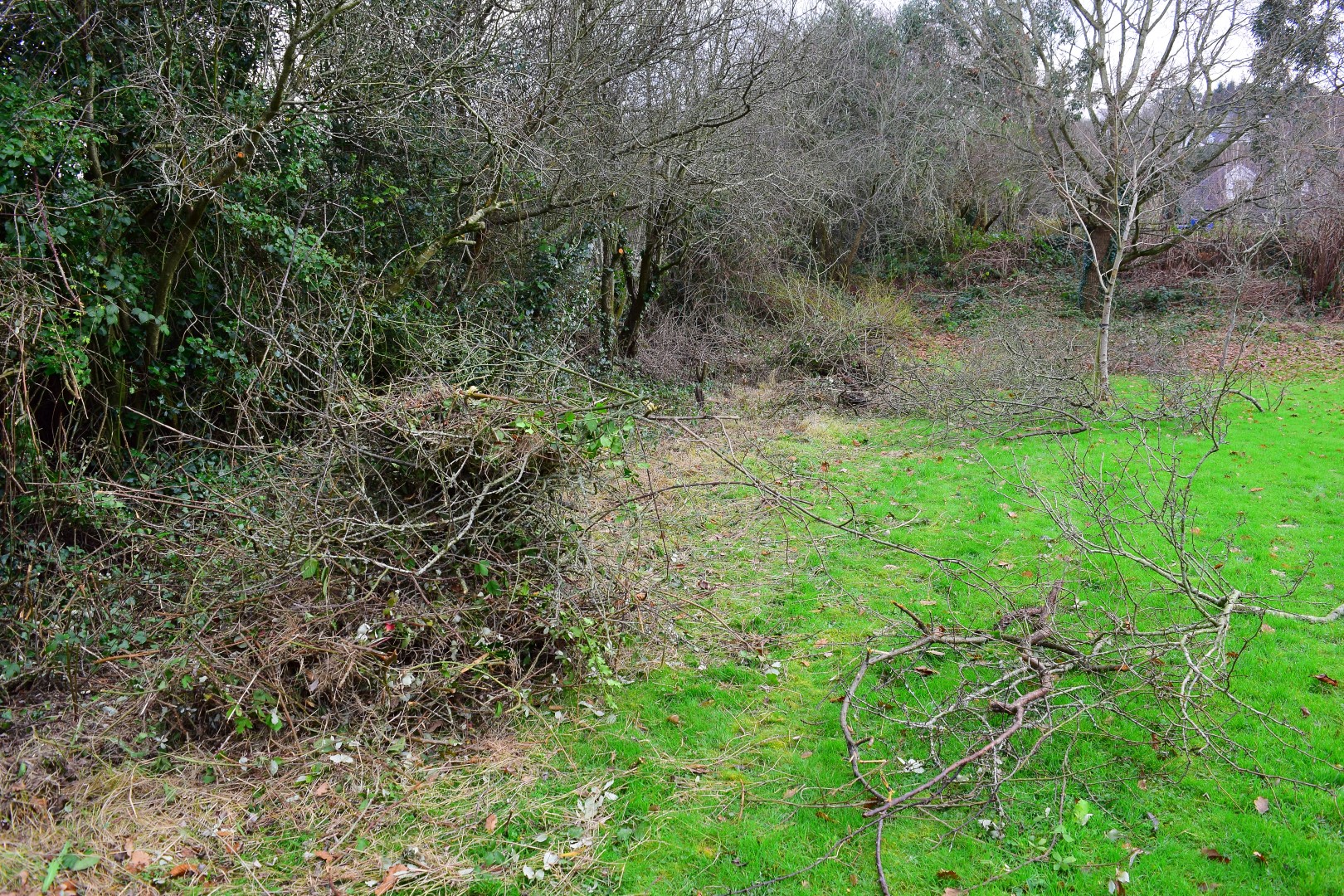
Ripping out brambles and black thorn branches December 20th 2016
Snezana on home leave from OSCE in Eastern Ukraine decided to make this hedge her next garden project and belted into it over Christmas and I have been working on it also with the first task being to cut down any overhanging black thorn branches as these can be lethal to the eyes and face and then ripping out the brambles which had scrambled through the entire hedge sometimes up to ten metres long … I wove most of the black thorn back into the ditch as it makes a great deterrent to deer incursions and some neighbouring donkeys and the rest I gathered into large heaps and burnt .
Through all this we recovered an area three metres wide by over thirty metres long and exposed some lovely holly and ash trees which had been smothered by the brambles and we will now be able to plant up some nice foliage and evergreen plants to bring some colour into the area as currently the dominant colour is green , we will take our time about replanting but already a list is forming in my mind , some elder shrubs such as sambuscus niger , the blue leafed variety and perhaps one or two of the golden leaf , some variegated eleagnus and maybe a silver birch or two … this is the fun part but the clearance itself was a brutal hard slog but worth it as it opens a new part of the garden and brings an ancient hedge back to life .
Typical intiative by Snezana , she finds a project , spends two hours hacking away at it then heads back to work in Ukraine and leaves me with seven days of pure slog , cutting down black thorn and ripping out brambles and burning them … but it remains Snezana’s “ Project ” when finished … I’m not complaining … just saying !!
And of course back in Ukraine she wants to micro manage and control … “ wait until I come home to select the plants ” etc . but I was in Glenconnor Garden Centre today for their New Year sale and assembled a good group of shrubs as a start on the new planting .
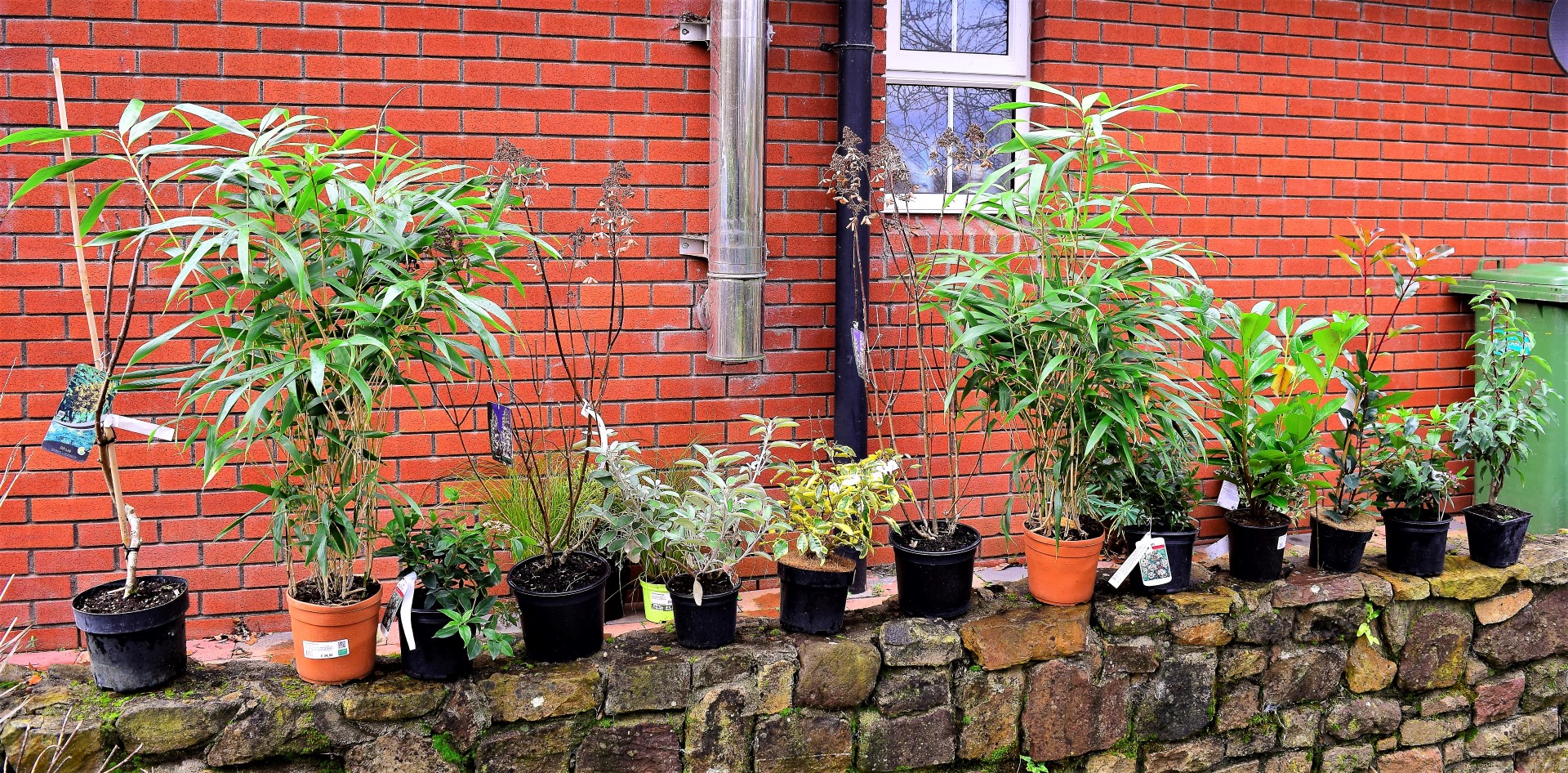
New shrubs for an old ditch January 2nd 2017
We had thought to add in a few native trees such as oak but thinking about it decided that there was already enough height in the hedge with the existing ash and blackthorn so we will concentrate on medium height shrubs and the new group include , viburnum tinus , a normal laurel and a portugeese variety , a grey leafed senecio , a mountain ash ( rhus sumac type or stags head antler ) , two hydrangeas , the paniculata variety , an eleagnus maculata gilt edged for all year colour and a bamboo .
I made a huge bonfire of the brambles from the ditch almost three metres high and lit it late this evening and sat there in the darkness until it burned away and there is something primitively enjoyable about sitting outside in the darkness on a cold night in January watching the flames and suddenly there was a couple of pairs of eyes looking out at me from the ditch , a family of foxes and it brought me back to a similar night in Macedonia in November 1995 when a group of us from the Skopje Climbing Club were lost coming down from the Sharplanina mountains and found ourselves spread out in twos and threes all over the ridge just above Tetovo … I was with Stoyan Toposki , a great friend during my two years in Macedonia and looking back at one stage on our slog back down the mountain , I saw lots of pairs of eyes in our torches and asked rather hopefully … cats , foxes … keep moving was his terse reply … wolves !!
The area we were in around Tetovo was Albanian and in Macedonia the Slav Macedonians and Albanian population don’t mix or integrate , in fact they have nothing to do with each other apart from an uneasy coexistence within Macedonia’s border but that night as we stumbled down the mountain just ahead of what looked like 20 wolves (they would never attack you but stayed about thirty metres behind and were a marvellous incentive to keep moving at a sharpish pace )… we passed through five or six Albanian villages and in each one we were met with great kindness and hospitality , we were no longer orthodox Macedonians just cold , lost and hungry travellers and in each village we were given hot drinks and apples and then each village sent a guide with us to the next village and in that way we were passed along until we reached the main road back to Skopje … I have never forgotten either the wolves or the hospitality we received along the way from the Albanian villages .
With Stoyan and the Skopje trekkers I spent a lot of weekends for two years walking all over Macedonia’s mountains , the Sharplanina in the north along the border with Kosovo and Albania and Pelister in the south along the border with Greece , the Pirrin range in Bulgaria and Mount Olympus in Greece … we slept in mountain huts and ate marvellous Balkan food all carried in rucksacks washed down with bottles of Tga Za Jug black wine from Kavadarci … I remember the comradeship of those weekends as if it was yesterday , I was the only foreigner in the group and those lovely people made me feel like one of themselves and I learned more about Balkan history , cuisine and culture in those two years than 20 years of reading history books about the region had given me … to this day Macedonia has a special place in my heart .

Crossing the Sharplanina Mountains between Albania and Macedonia , Snezana , September 1995
A garden writer I admire is the UK Telegraph gardening correspondent , Tim Richardson , who has just published a collection of his gardening essays called “ You should have been here last week ” , he is an academic and as he writes “ my preferred subject is not horticulture but garden culture so if an editor asks for 800 words on sweet pea then I have to decline however if asked to supply a written piece about the symbolic properties of sweet pea or their place in the history of the herbaceous border then that I can supply ” … not a sweet pea expert then nor remotely interested is Tim !
He has written the encyclopaedic standard gardening work three years ago “ The English Garden ” and calls a spade a spade when dealing with the stuff shirt types who administer both the UK National Trust and the Royal Horticultural Society ,
One of his essays deals with how he first became interested in gardening and interestingly although he himself is not a hands on gardener both his grandfathers and great grandfathers were professional Head Gardeners at famous estates in England .
It is always interesting to ask gardeners how they got the gardening bug certainly in Ireland where there are no big estates anymore and consequently no professional gardeners and any I have met have enough of gardening in the day job and rarely grow more than a few vegetables at home .
In my own case neither of my parents were interested in gardening , my Father’s gardening year started and ended in May each year when he planted out two trays of bedding annuals , white allysum and blue lobelia with the odd petunia thrown in while my Mam concentrated on a patch of rhubarb out the back which she doused each morning with ashes from the fire … I grow rhubarb but have never managed to get the quality she got but her Mother , my Nana Nonie , had a cottage garden from the 1930’s with roses , cabbages ,onions and flowers , a proper cottage garden with a small rockery and a path running around it which was unusual for that time but Nana passed away when I was a teenager and I never had the opportunity to ask her how she got the interest to create what was really an unusual garden , she also kept pigs and had a horse and a few asses and an early memory is of Nana putting the dung around the rose bushes and pouring Jeyes fluid on the roots of the roses for what she called black spot … I was very young at the time and the Irish Army had just sent it’s first contingent ever abroad in August 1960 to the Congo where they were attacked at a place called Niemba ( and 11 soldiers killed and eaten ) by a tribe called the Balubas … until recently if you wanted to scare a child in Ireland you told him / her that the balubas would get them and my sisters were regularly told by my Father when they looked particularly scruffy which was often as six year olds that they looked like balubas … so when Nana spoke about black spot I thought immediately balubas … not PC I know but memory retains the unusual incidents from childhood !
In my experience there are several types of gardeners , those who pragmatically grow only what they can eat , those who want a “ maintenance free ” garden that is done once and rarely needs to be touched , the fussy type who are unhappy unless every inch of soil is weed free whose plants stay in their allocated place and don’t stray and I maintain none of these gardeners actually enjoy their gardens whereas I feel the breed who prefer the blowsy informality of a natural garden style get the most out of gardening . Nothing wrong with any of those stereotypes and I see all those types in my own style as for example I don’t spend time growing vegetables and cultivate only herbs I will eat , I am manic about keeping weed free beds and paths but overall my gardening style would be for wild informality .
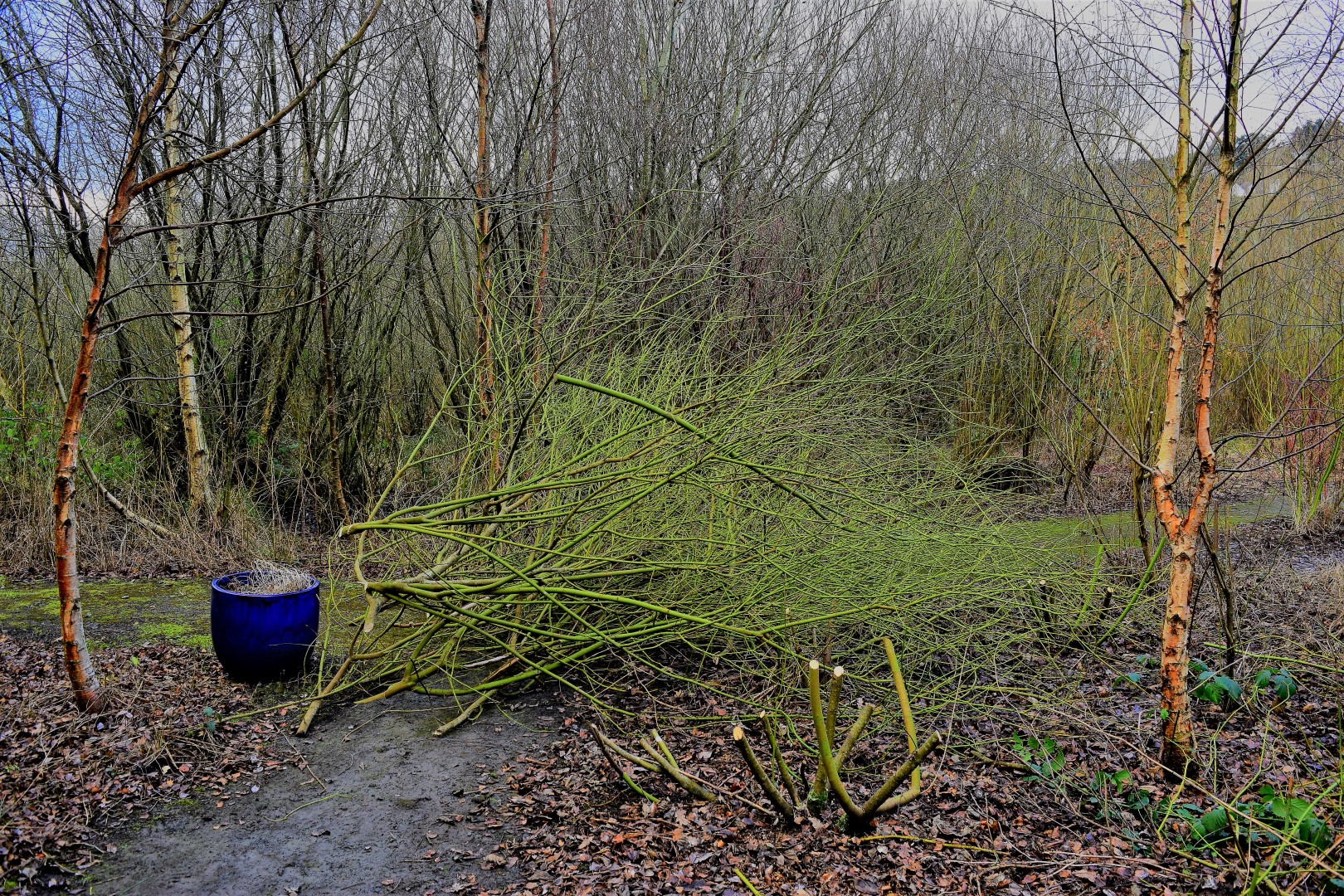
Cutting back over grown golden dogwoodin the Lower Garden January 15th 2017
I spent three days with Peter and his chain saw in mid January pruning hard the willow trees in the Lower Garden and he set up an industrial shredder which got rid of all the branches while we stacked the log sized wood . Three mature conifers had died during last year’s winter flooding and I was reluctant to cut them down as they formed a large chunk in the woodland area and I felt they would leave a gaping hole however so many visitors had commented on their obviously dead colour that they had to go and to my surprise their removal showed that they really had added nothing to an area mainly of deciduous trees and the area felt immediately lighter … don’t get me wrong , I would never have removed the conifers if they had remained healthy but as so often happens in nature new possibilities opened up .
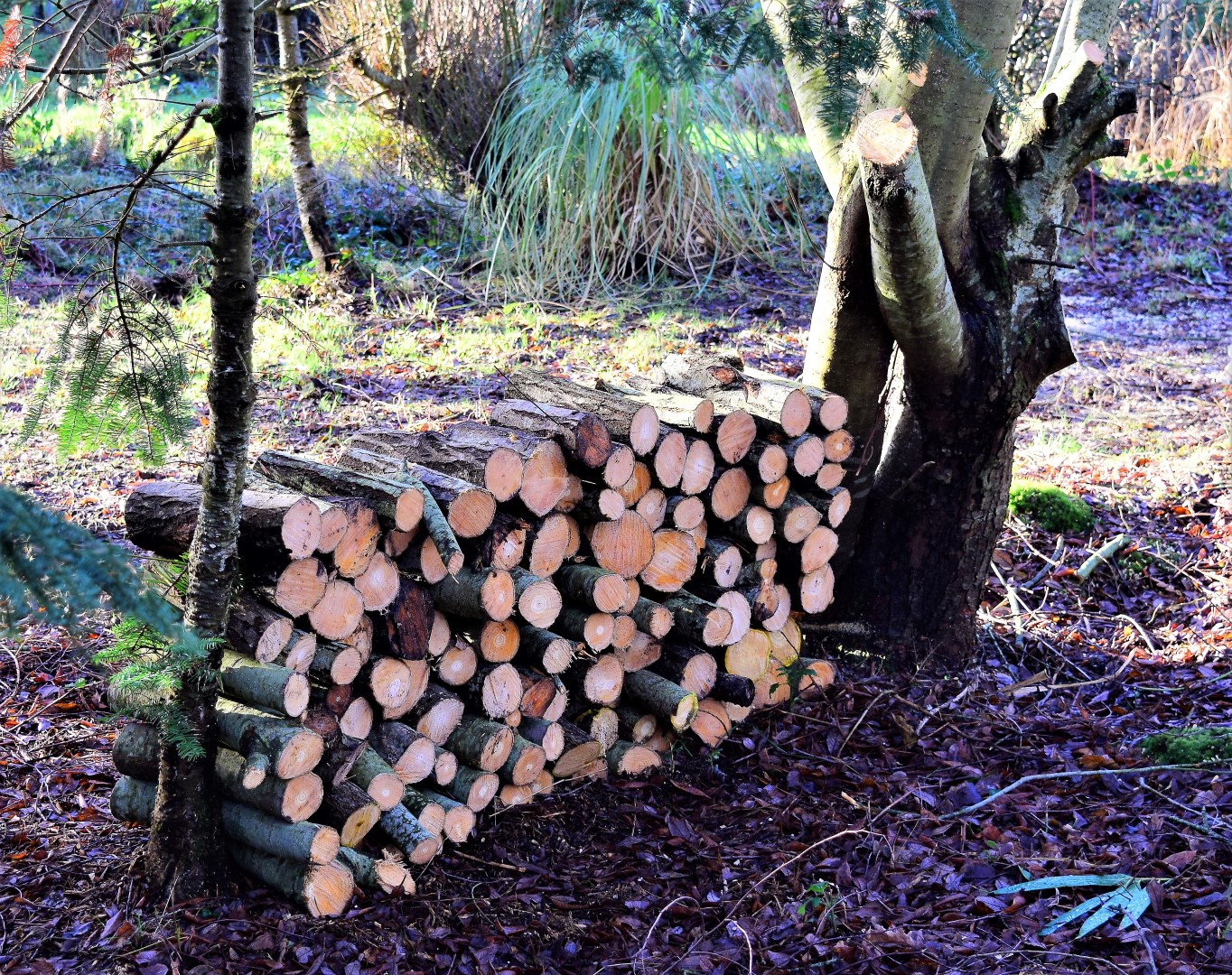
A new bug hotel in the Lower Garden , January 20th 2017
In their place we planted a silver birch which linked to the row of mature silver birch already lining the path and across from it a fairly mature root balled red oak and planted seven viburnum davidii around the silver birch and later in the Spring I will fill in the spaces with my favourite geranium biokovo of which I always have 6/ 7 pots of slips growing on an ongoing basis ( when one lot of pots is rooted and planted out I immediately plant up the pots again with more geranium cuttings ) .
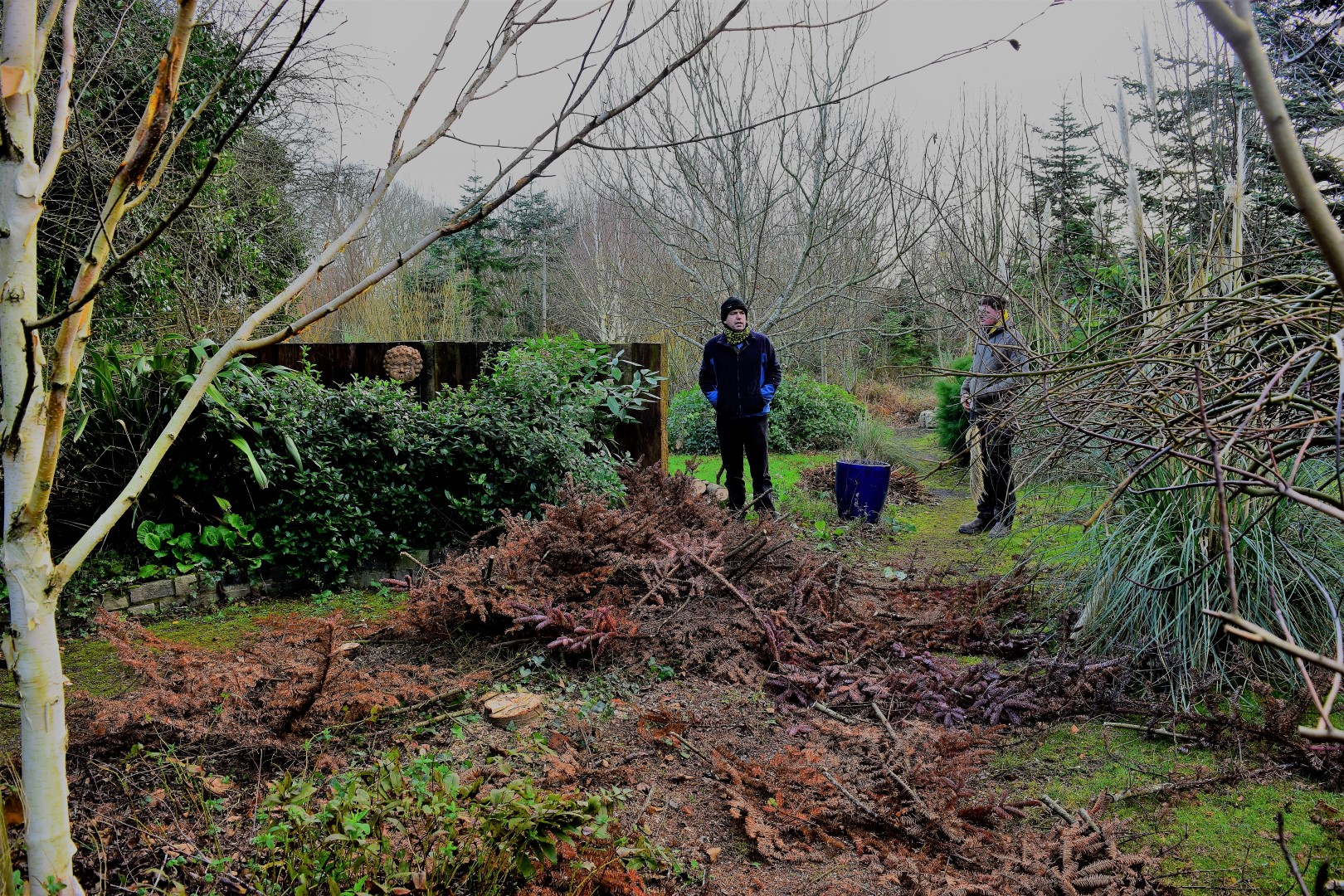
An empty space where we removed two dead conifers , January 18th 2017
A new red leafed oak fills the empty space January 18th 2017
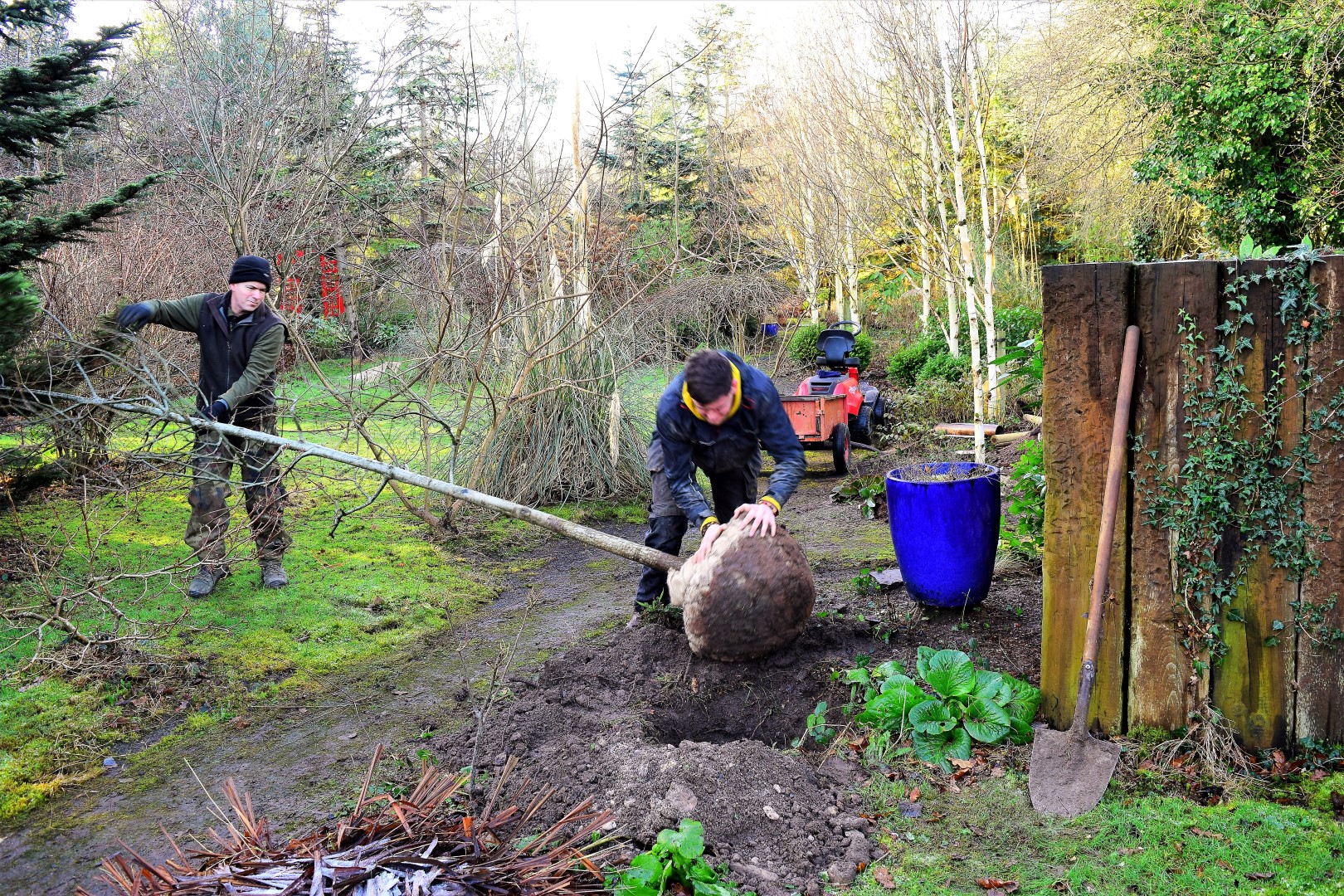
I sometimes buy root balled trees from a specialist nursery as they are pretty mature and you get instant impact where you need it , these are trees have been growing in the ground for up to fifteen years but are lifted by the grower on a yearly basis and their roots trimmed back , pricey but you get what you pay for and a tree that has been given individual attention throughout it’s growing life and after a year or two in it’s new position the roots explode into the surrounding soil and really take off .
These root balled trees are heavy though and need two people to get them into position as in the case of these three silver birch added at the same time last week . These specimens had been left too long in the ground by the grower a few years ago during the economic bust and they became too big to sell on so rather than shred them he cut them down to a metre high from where they regrew into multi stemmed type trees after five years , Peter heard about them and we snapped up three at a fraction of what you would pay for genuine multi stemmed silver birch … we planted them along Snezana’s ” ditch ” where they add terrific light already .
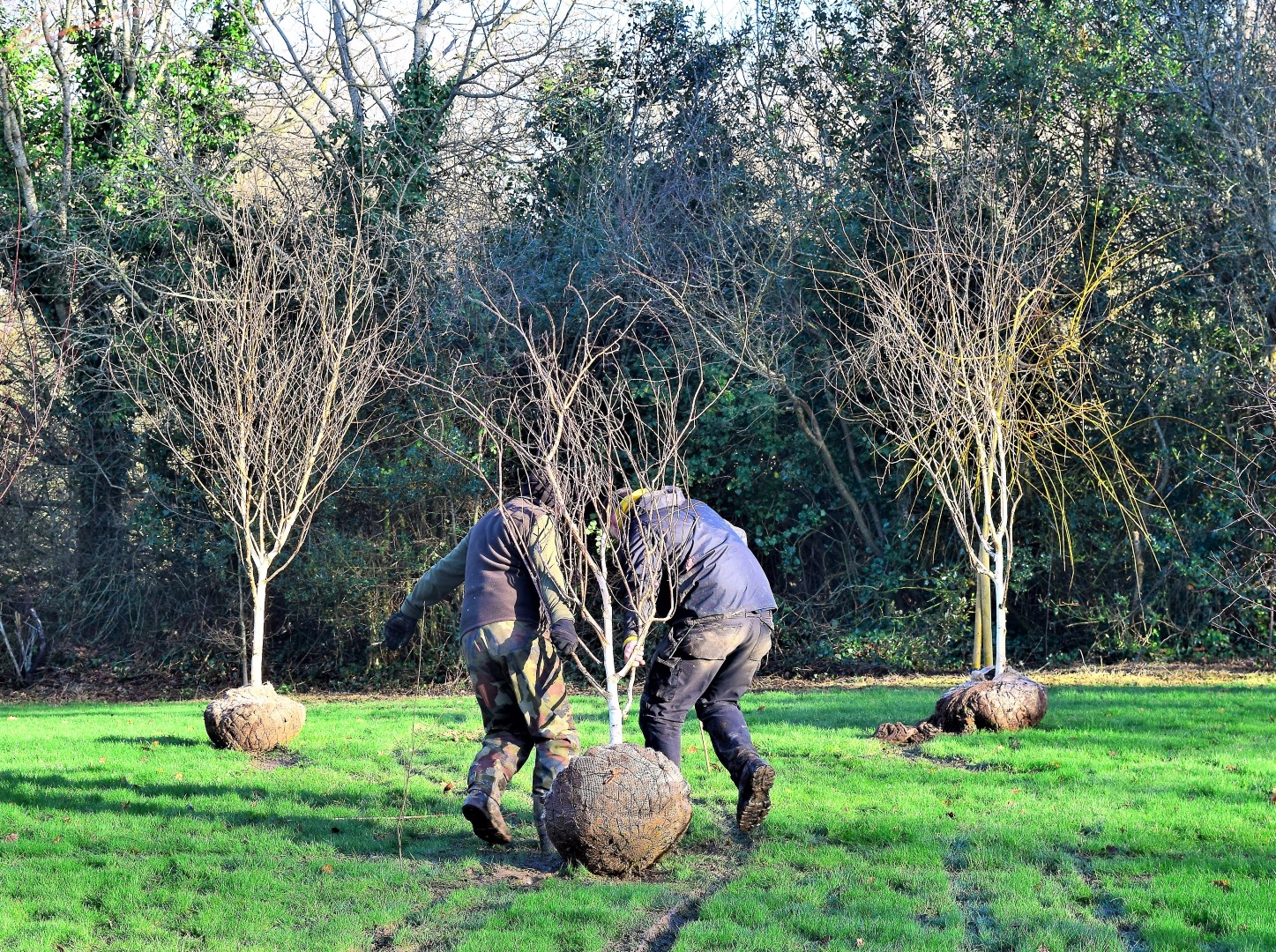
A new planting of three silver birch along the reclaimed ditch , January 18th 2017
Viburnum davidii has never been in my first tier of plants , originally from West China and evergreen it is an excellent ground cover and grows into a small domed shape about a metre across which will look great under the silver birch … my first choice had been vinca but I saw the viburnum in Glenconnor Garden Centre and knew immediately they would look and grow well in this dryish woodland setting with dappled shade .
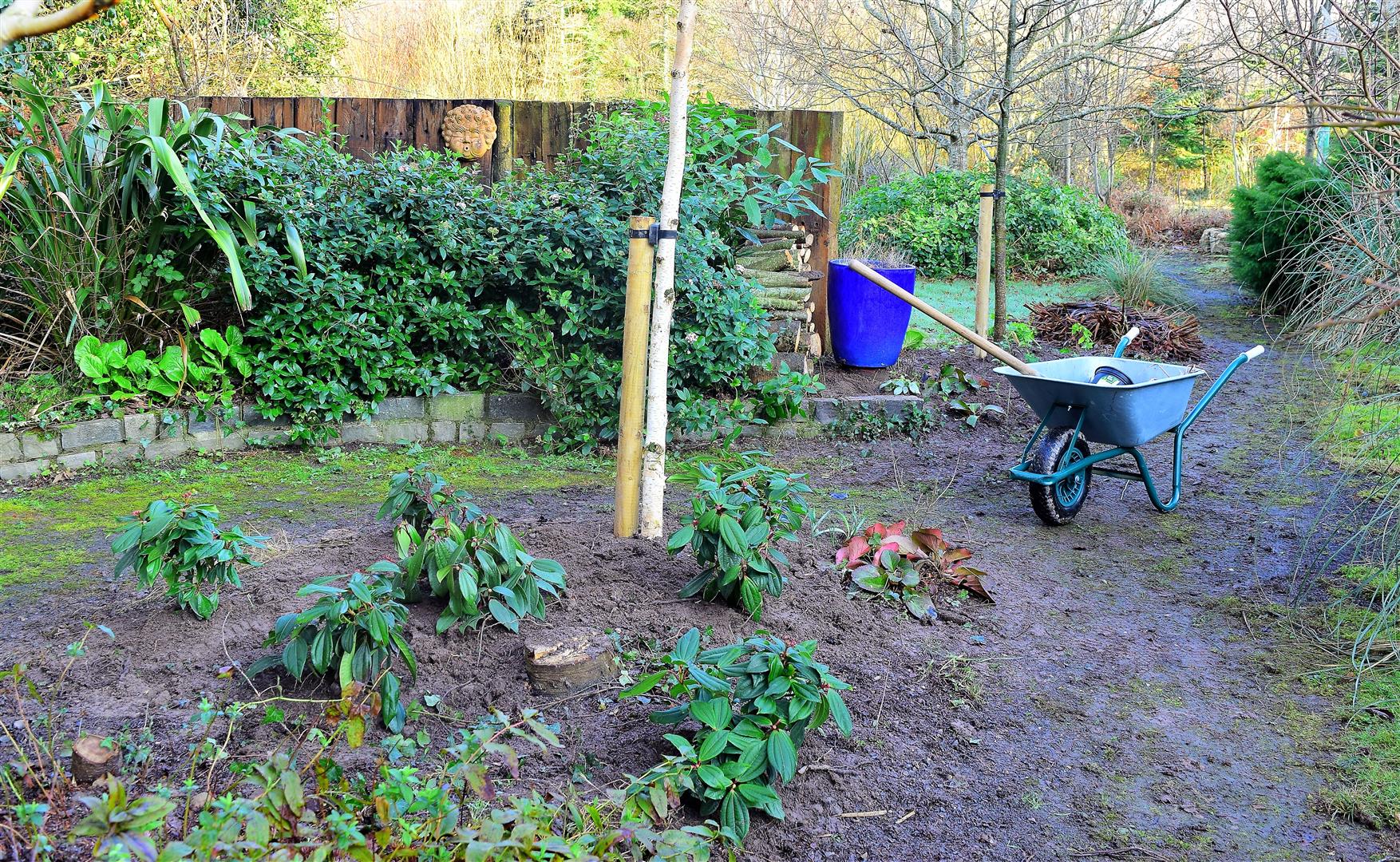
New Silver Birch underplanted with viburnum davidii January 24th 2015
I will plant vinca and geranium under the red oak all of which I have already growing on in pots having been slipped last October.
Today I cut back hard all the miscanthus grass as I had got November , December and January out of the dried foliage and if left any longer the new growth would preclude any hard pruning and it is also time to get into the grass borders and give a winter cleaning . A plant combination I like is to grow eucalyptus trees through the miscanthus and these I prune to about two metres when they take off after about three years in the ground and this keeps a nice green colour in what is called juvenile growth otherwise eucalyptus grows into the sky and has a long green / brown leaf which is not as fresh looking as the young growth and this hard pruning also maintains a smaller leaf .
The famous gardening phrase “ the first year they sleep , the second year they creep , the third year they LEAP ” could have been written with eucalyptus in mind !
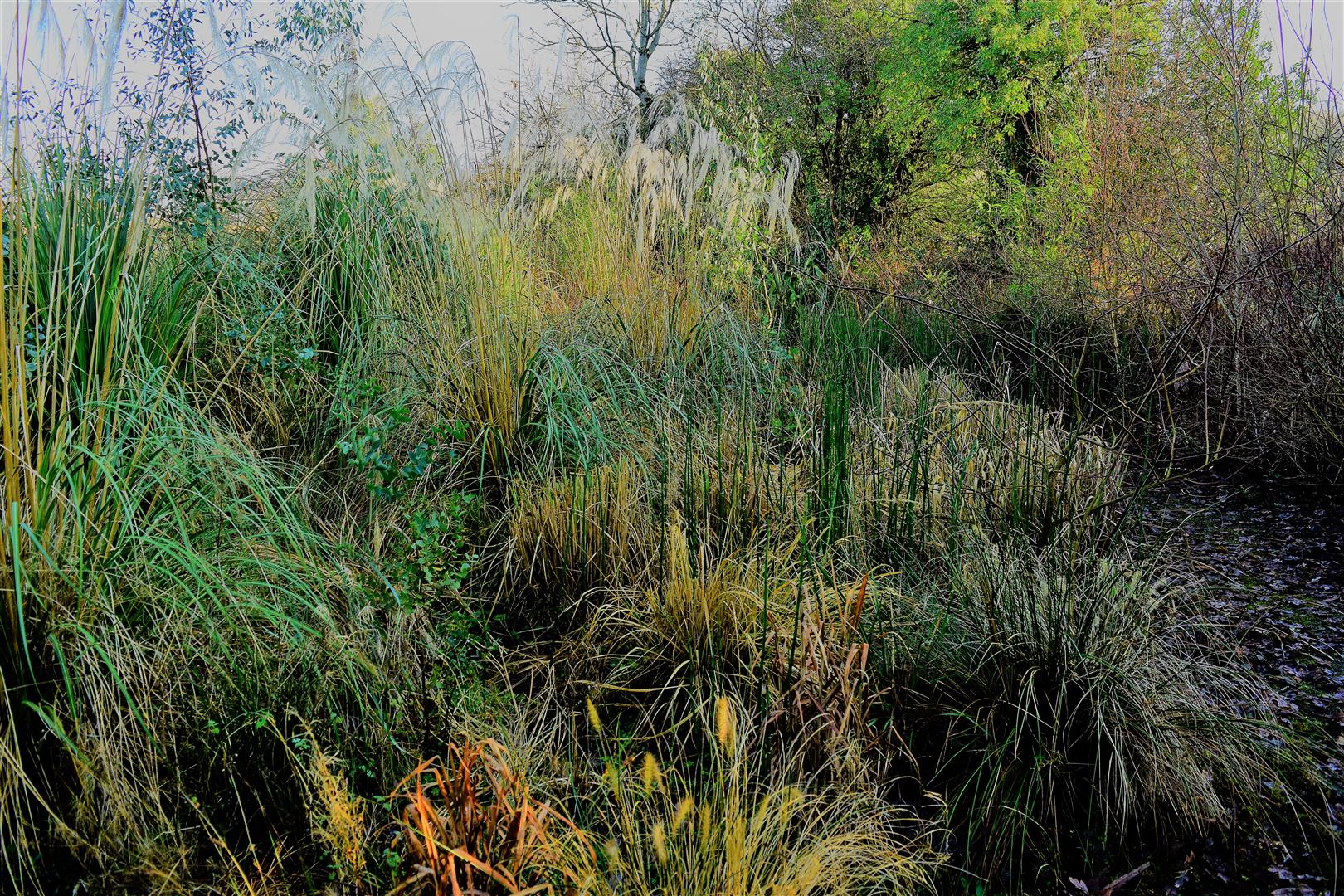
The grass area after it’s scalping in late January 2017
Some late January sun while I was cutting back the grass borders .
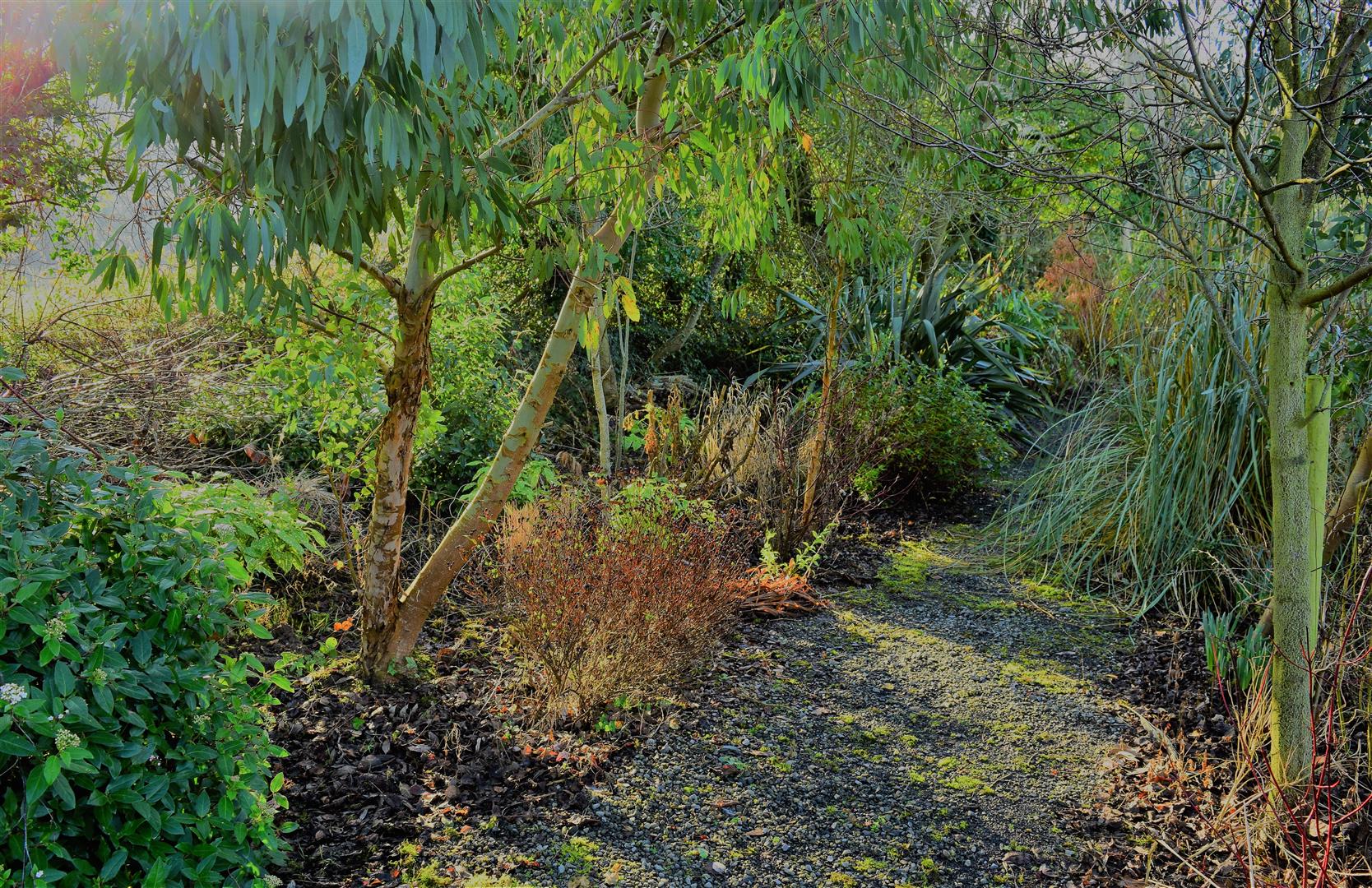
Late January sun in the top garden area , January 24th 2017
I am often asked how long I spend in the garden every day , as I am sure all gardeners are, and for me there is no set answer as every day varies depending on whether I am working on a project or when in the May/ October months I am expecting garden visitors in which case I am very busy but generally I work in the garden on a daily basis all year round … sometimes like today this can just be an hour’s walk around with a secateurs in hand cutting back willows or dog woods … but I make a point of being in the garden however briefly EVERY day because I love being outside in nature , it lifts the spirit and I find it relaxing and when I come back inside especially in bad weather that I have earned the next few hours in front of the TV !
The 1st of February , Saint Brigid’s Day , is traditionally the first day of Spring in Ireland so onwards and upwards towards the new season , get out and enjoy the Spring visitors to the garden such as this robin who regularly hops onto my tray when outside for a mug of tea at this time of year !

A regular garden visitor , front garden January 2009


Leave a Reply